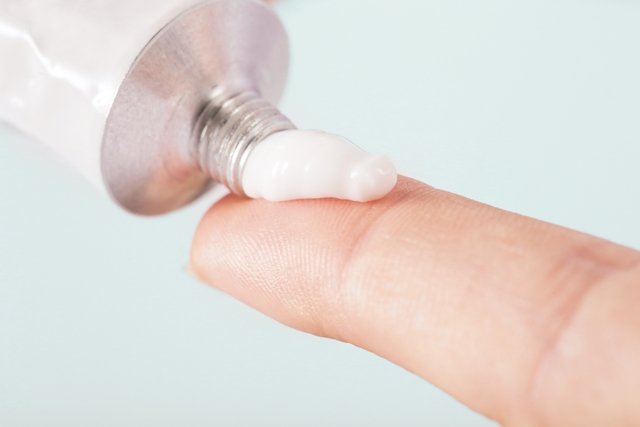Ointments for candidiasis contain substances with antifungal action, which act to inhibit the growth and multiplication of the fungus that causes candidiasis, helping to alleviate symptoms of irritation, itching, redness, swelling or discharge.
Candidiasis is an infection caused by excessive proliferation of the fungus Candida albicans, mainly in the genital region, and can affect women or men of any age. Learn how to identify the symptoms of candidiasis.
Candidiasis ointments can be purchased at pharmacies or drugstores and are generally sold without a prescription for adult use. However, it is important to consult a gynecologist or urologist to assess whether there is another type of infection that is causing the symptoms and whether any other ointment or specific treatment is necessary.
6 ointments for candidiasis
The main ointments used to treat candidiasis are:
1. Clotrimazole
Clotrimazole ointment works by inhibiting the growth of Candida albicans, relieving symptoms of itching, redness and discharge in the genital region.
This ointment can be found under the commercial name Gino-canesten vaginal cream or under the generic name Clotrimazole, containing 3 or 6 vaginal applicators for use in women, but it can also be used for male candidiasis.
How to use: In the case of women, apply clotrimazole vaginal ointment once a day, preferably at night, for 3 or 6 days, according to medical advice. This ointment must be applied deeply into the vaginal canal, using the applicator provided in the packaging and must not be used during menstruation.
In the case of men, clotrimazole ointment should be applied to the glans and foreskin twice a day, for 1 to 3 weeks, as advised by the urologist.
It is recommended to avoid sexual intercourse during treatment, as candidiasis can be transmitted to the partner and clotrimazole cream can reduce the effectiveness of the condom or diaphragm. See other ways to use clotrimazole for candidiasis.
2. Nystatin
Nystatin ointment prevents the growth and multiplication of Candida albicans, relieving the symptoms of candidiasis in women or men.
This ointment can be found in pharmacies or drugstores under the trade name Micostatin or in generic form as Nystatin, containing 10 or 14 vaginal applicators.
How to use: In the case of women, nystatin ointment should be used once a day, preferably at night, for 10 to 14 days, according to medical advice. The ointment must be applied deeply into the vaginal canal, using the applicator and its use must not be interrupted during menstruation. If the symptoms do not disappear within 14 days, you should return to the doctor. See more details on how to use nystatin.
In the case of men, nystatin ointment should be used 1 or 2 times a day, for 1 to 3 weeks, applying ointment to the glans and foreskin.
3. Miconazole
Miconazole ointment helps to alleviate the symptoms of itching, redness or discharge caused by candidiasis in women or men, as it works by eliminating Candida albicans from the genital region, and can also be used for anal candidiasis.
This ointment can be found in generic form as Miconazole Nitrate, containing 14 vaginal applicators.
How to use: for women, miconazole vaginal ointment should be applied once a day, preferably at night, for 14 consecutive days. Use the applicator provided in the package to apply the ointment as deeply as possible into the vaginal canal.
For men, it is recommended to apply miconazole ointment to the glans and foreskin, twice a day, for 1 to 3 weeks. In addition, the urologist may also recommend the use of fluconazole tablets in a single dose. Check out other treatment options for male candidiasis
4. Tioconazol + tinidazol
Tioconazole and tinidazole ointment is indicated for the treatment of vaginal candidiasis or other vaginal infections such as trichomoniasis or Gardnerella.
This ointment can be found in generic form as Tioconazole + Tinidazole, in packages containing 7 vaginal applicators.
How to use: Apply the ointment deeply into the vaginal canal, using the applicator, once a day, at night, for 7 days, preferably outside the menstrual period. In some cases, the doctor may recommend using the ointment twice a day for 3 days.
5. Isoconazol
Isoconazole ointment works by eliminating the fungus that causes vaginal candidiasis, helping to relieve symptoms of itching, redness or vaginal discharge.
This ointment can be found under the trade names Gyno-Icaden or Gynoplus, or in generic form as Isoconazole Nitrate, containing 7 vaginal applicators.
How to use: Apply isoconazole vaginal ointment, as deep as possible into the vagina, using the applicator, once a day, preferably at night, for 7 consecutive days. This ointment may reduce the effectiveness of the condom or diaphragm and may not be effective in preventing pregnancy or protecting against sexually transmitted diseases.
6. Fenticonazole nitrate
Fenticonazole nitrate ointment is indicated for vaginal candidiasis and vulvovaginitis caused by the fungus Candida albicans, as it works to eliminate the fungus, relieving symptoms of itching, irritation, redness and vaginal discharge.
This ointment can be found in its generic form as “fenticonazole nitrate” or under the trade names Ginna, Fentizol or Vagicand, containing 7 vaginal applicators.
How to use: Apply fenticonazole nitrate ointment deep into the vaginal canal, using the vaginal applicator, once a day, preferably at night, for 7 days. Discard the applicator after use. Fenticonazole nitrate can also be found in the form of vaginal ovules. Learn how to use fenticonazole nitrate vaginal ovule.
Read too: 6 ointments for cuts in private parts (and how to use them)
Possible side effects
Some of the most common side effects that may occur during treatment with candidiasis ointments are redness, swelling, burning, bleeding, vaginal or penile itching, or abdominal pain.
Who shouldn’t use
Candidiasis ointments should not be used by children, pregnant or breastfeeding women, or in cases of allergies to any of the ointments’ components.
These ointments should also not be used by people who are allergic to antifungals such as clotrimazole, miconazole, tioconazole, tinidazole, nystatin, isoconazole, fluconazole or itraconazole, for example. Additionally, clotrimazole ointment should not be used by women or men who are allergic to cetostearyl alcohol.
Candidiasis ointments are not recommended for women who have symptoms such as fever, abdominal or back pain, nausea or foul-smelling discharge or vaginal bleeding. In these cases, you should consult your gynecologist.
Care during treatment
Some precautions when treating candidiasis ointments include:
- Wash and dry your hands and intimate area, removing traces of the ointment previously applied;
- Have good body hygiene, keeping the intimate area very dry;
- Wear loose cotton clothing;
- Drink plenty of fluids;
- Avoid the consumption of alcohol, sugar and fatty foods.
Furthermore, in the case of female candidiasis, tampons, vaginal douches or spermicides should not be used during treatment.
It is important to follow medical recommendations when using candidiasis ointments, and continue applying the ointment for the time determined by the doctor, even if the symptoms improve quickly.
How to cure candidiasis faster
Some simple measures, such as eating a diet low in sugar to help the body fight the growth of fungi more easily or using probiotics, can help cure candidiasis faster, supporting the treatment recommended by the doctor, or preventing candidiasis from returning.

Sign up for our newsletter and stay up to date with exclusive news
that can transform your routine!
Warning: Undefined array key "title" in /home/storelat/public_html/wp-content/plugins/link-whisper-premium/templates/frontend/related-posts.php on line 12
Warning: Undefined array key "title_tag" in /home/storelat/public_html/wp-content/plugins/link-whisper-premium/templates/frontend/related-posts.php on line 13




